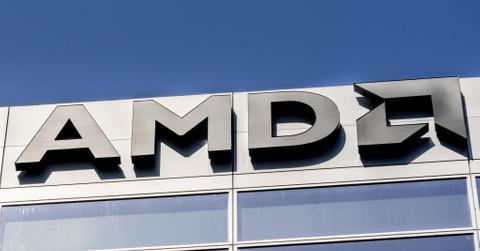AMD Stock Fell Due to Disappointing Guidance
AMD reported upbeat fourth-quarter results on Tuesday after the market closed. The company posted better-than-expected revenue and earnings in the quarter.
Jan. 29 2020, Published 8:32 a.m. ET

Advanced Micro Devices (NYSE:AMD) reported upbeat fourth-quarter results on Tuesday after the market closed. The company posted better-than-expected revenue and earnings in the quarter. However, investors were disappointed by the company’s weak revenue guidance for the first quarter and fiscal 2020. AMD stock rose 2.58% to $50.53 on the day. At the closing price, the company’s market capitalization was $56.3 billion. After AMD reported its earnings, the stock fell by 4.43% to $48.29 in extended trading on Tuesday.
AMD’s fourth-quarter earnings
AMD reported strong fourth-quarter results on Tuesday after the market bell. The company beat analysts’ revenue and earnings estimates in the fourth quarter.
The company reported an adjusted EPS of $0.32 in the fourth quarter. AMD’s earnings beat analysts’ estimates by $0.01 per share. Also, the revenues of $2.13 billion beat analysts’ estimates of $2.11 billion. The revenues in the fourth quarter rose by about 49.9% YoY (year-over-year) from $1.42 billion.
In the fourth quarter, AMD’s Computing and Graphics segment’s revenues rose 68.6% YoY to $1.66 billion—more than analysts’ consensus estimate of $1.50 billion. The company’s Enterprise, Embedded, and Semi-Custom segment’s revenues rose 7.4% YoY to $465 million—lower than analysts’ consensus estimate of $604 million.
Expectations for the first quarter and fiscal 2020
AMD expects first-quarter revenues of $1.8 billion (plus or minus $50 million), down 15.4% sequentially and up 41.5% YoY. The company’s sales outlook for the first quarter was lower than FactSet’s consensus estimate of $1.86 billion. For fiscal 2020, AMD expects its revenue growth to be 28%–30%, which is in line with analysts’ consensus estimates.
AMD’s management also expects the company’s gross margin to be about 46% in the first quarter, which is higher than 41% in the first quarter of 2019. The company’s operating expenses will likely grow by around 16.5% YoY to $580 million in the first quarter.
According to a MarketWatch report, “Weakness in the revenue outlook going forward is linked to gaming-console chip sales, which have been soft ahead of console makers Sony Corp. and Microsoft Corp. rolling out new PlayStations and Xboxes later in the year.”
The report also said, “AMD said in a statement that the sequential decline in revenue going into the first quarter is driven primarily by negligible semi-custom revenue which continues to soften in advance of the ramp of next-generation products, in addition to seasonality.”
Analysts revised AMD’s target price
Many analysts revised their target price for AMD stock after the fourth-quarter earnings results. On Wednesday, J.P. Morgan analyst Harlan Sur increased its target price on AMD stock to $45 from $34. He maintained the “neutral” rating on the stock. According to a report from TheFly, “The company last night reported solid results and full-year guidance with strong broad-based growth across its business segments, Sur tells investors in a post-earnings research note.” The report also said, “However, with Intel’s advanced 14nm and 10nm products coming to market this year, the analyst expects AMD’s share gains to begin to moderate later in the year.”
On Wednesday, Piper Sandler increased its target price on AMD stock to $45 from $40. Jefferies raised its target price estimate to $58 from $56. Deutsche Bank increased its target price on AMD stock to $42 from $40. UBS also raised its target price estimate to $52 from $34. However, Exane BNP Paribas analyst Jerome Ramel downgraded the stock to “neutral” from “outperform” with a target price of $47.
About 40 analysts cover AMD stock as of today. Among the analysts, 16 recommend a “buy,” 22 recommend a “hold,” and two recommend a “sell.”
Currently, analysts have a 12-month target price of $45.63 on AMD stock. On Tuesday, the stock was trading at a premium of 9.7% to analysts’ 12-month target price. The median target price was $46.00 on the same date.
Technical level
AMD stock was trading 4.3% below its 52-week high of $52.81 and 140.2% above its 52-week low of $21.04. Based on the closing price on Tuesday, the stock was trading 3.0% above its 20-day moving average of $49.06. The stock is also trading 14.1% above its 50-day moving average of $44.27 and 33.4% above its 100-day moving average of $37.89.
AMD’s 14-day RSI (relative strength index) score is 64. The score shows that the stock is approaching the overbought zone. The company’s upper, middle, and lower Bollinger Band levels are $52.28, $49.06, and $45.84, respectively. On Tuesday, the stock closed near its middle Bollinger Band level, which indicated that it isn’t oversold or overbought.
AMD stock has gained 150.4% in the last 12 months. In comparison, the S&P 500 Index has risen by 24.1%. Intel (NASDAQ:INTC) and Nvidia (NASDAQ:NVDA) have gained 44.1% and 79.7%, respectively, in the last 12 months. Other chip stocks including Micron (NASDAQ:MU), Qualcomm, and Broadcom (NASDAQ:AVGO) have returned 48.3%, 76.1%, and 18.9%, respectively.
Read Can AMD Stock Rally more on Analysts’ Upgrades? and What Drove AMD Stock to a New High of $49? to learn more.
